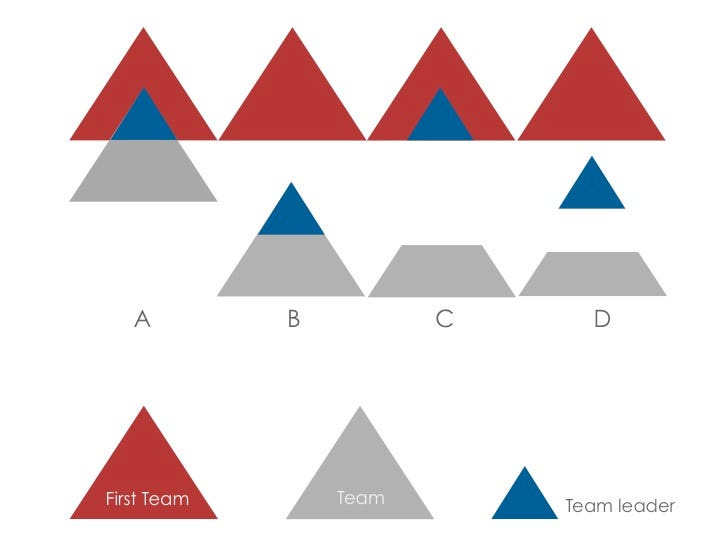A Roadmap to Organizational Success: Navigating with a First Team Mindset
How to foster cohesion, collaboration, and accountability at the highest levels
Greetings, Substack reader!
If you're reading this, chances are you've led or are leading a team where everyone might be pulling in their own direction, like horses in a disjointed chariot. Each is powerful but without unified intent, you're going nowhere fast. In an era where terms like 'synergy' and 'team alignment' are often reduced to buzzwords in corporate presentations, it's time to dust off the cliches and dig into something much more substantial—the "First Team Mindset." This is not just another feel-good catchphrase; it’s a transformative paradigm that can redefine how leadership navigates the complex game of organizational performance. Let's unpack this.
Below are the four key takeaways you can expect from this newsletter, followed by our in-depth article that delves into these principles in greater detail. Finally, I’m sharing strategies you can leverage to foster a first team mindset.
🌟 4 Key Takeaways from this newsletter
Unmatched Importance of Leadership Alignment: Your senior leadership team is the bedrock of your organization's culture and success. A "First Team Mindset" ensures that the senior leadership is aligned, focusing on collective goals over individual departmental objectives. This alignment at the top cascades down, affecting every layer of the organization in a positive manner.
Challenges Are Real but Overcomeable: Implementing a First Team Mindset is far from easy. From departmental silos to lack of trust and communication barriers, the obstacles are manifold. Yet, the reward of overcoming these challenges is a more cohesive, efficient, and successful organization.
Actionable Tools for Building Alignment: Off-site strategy meetings, executive coaching, transparent reporting, and inter-departmental meetings are some of the actionable steps that can facilitate better alignment and a First Team Mindset.
Empirical Backing for Alignment: Companies with well-aligned and engaged teams are 21% more profitable, according to Gallup. McKinsey's research also shows that companies with excellent leadership alignment outperform their peers in terms of revenue and profitability by a ratio of 2-to-1.
How a ‘First Team Mindset’ Fuels Organizational Performance
A Strategic framework for enhancing team alignment and accountability
In the realm of leadership, the concept of a “First Team Mindset” is not merely a buzzword; it’s a strategic framework for success. I’ve discussed the importance of adopting a first team mindset in previous posts. If you haven’t yet, you can read about how to unlock organizational success here and also explore the critical importance of senior leadership team alignment here.
The Essence of the “First Team Mindset”
In brief, the “First Team Mindset” encourages leaders and team members to prioritize the collective goals of their immediate “first team” — often the senior leadership team — over those of their department. This mindset fosters cross-functional collaboration and aligns everyone toward achieving overarching organizational objectives, which in turn drives performance and competitiveness.
Why This Matters to Me
Over the years, my experience as an HR leader taught me one critical lesson: the greatest driver of organizational culture and success is a well-aligned senior leadership team. No HR program, employee benefit, or inspiring CEO speech can substitute for it. When I say “it starts at the top,” I trully mean it.
After years of leading teams in the tech sector, my greatest lesson has been the power of prioritizing my executive team as my ‘First Team.’ With this shift, the results were clear: projects didn’t just succeed; they excelled. And the organization benefited in ways beyond our metrics.
How to Assess Your Team’s Alignment
Imagine a leadership team so divided that their primary concern is their individual agendas rather than organizational objectives. Or a leadership so disconnected they are unaware of the daily operations on the shop floor. Such misalignment is not just hypothetical; it is a disruptive reality that many companies face.
Wondering whether your senior leadership team embraces a First Team Mindset? I’ve developed a quick, 7-minute survey to help you gauge your current state. You can access it here.
For a broader perspective, consider the following criteria:
Alignment with Organizational Goals: Is your team unified by a common mission?
Cross-Functional Collaboration: Is there active sharing of information across departments?
Shared Accountability: Do you collectively celebrate success and learn from failures?
Open Communication: Is there a culture of transparent & candid discussions about organizational challenges and opportunities?
Decision-Making: Are decisions made considering their impact on the entire organization?
And many more. These indicators offer a robust evaluation of whether your team operates with a First Team Mindset.
Challenges to Navigating a First Team Mindset
Implementing a “First Team Mindset” is easier said than done for several reasons:
Silo Mentality: Departments often work in isolation, focusing solely on their immediate goals because it’s usually your expertise and comfort zone. Again, it’s normal to have a default mode like this. Especially in smaller companies and in person you might have been able to get the necessary context to operate in Silo but this doesnt scale.
Individual Goals and Incentives: Performance metrics usually prioritize specific, localized outcomes, making it hard to shift focus toward global objectives. If each department have objectives that doesn't roll up exactly with the overarching company goal or worst, some departmental objectives are counterproductive for another department, “Houston we have a problem!”
Lack of Trust: A culture where mistrust prevails will inhibit the open sharing of information and resources across departments. The intention can be to trust your colleagues but in a fast paced world of back to back meetings, taking the time to understand our peers and their reality is challenging. Building trust, start with having the context to build empathy.
Human Nature: We are psychologically inclined to bond with those we work closest with, making the expansion of one’s ‘team mindset’ a conscious effort.
Fear of Loss: The potential for resource cuts or reduced recognition can make departments hesitant to adopt a first team mindset.Again we are human being and have protective tendencies.
Organizational Complexity: The larger and more complex the organization, the harder it is to implement a unified approach.
Communication Barriers: Poor communication can result in a lack of organizational alignment, making it difficult for leadership to drive a unified vision. When I say poor, it’s without any judgement, I have been there and we are all doing our best but stakeholder management, priorities, deadlines, life… often get in the way, this is truly hard.
Based on my years experience, creating a First Team mindset isn’t just about setting a rule; it’s about building a culture. It requires shared experiences, clear communication, and above all, a dedication to shared objectives.
According to a Gallup poll, companies with high employee engagement and alignment are 21% more profitable than those without. Similarly, a McKinsey study shows that organizations with excellent leadership alignment outperform their peers by a margin of 2-to-1 in terms of revenue and profitability.
The Way Forward
If alignment is lacking in your organization, it’s crucial to address it head-on. Stats like the ones above can bolster your case when advocating for a more aligned leadership team. But remember, as a leader yourself, you can influence your immediate environment. Use the diagnostic tools available, like the survey mentioned, to assess both your team and the teams you’re part of. If you got a new team or just joined an organisation it’s just perfect timing to start things right.
Adopting a “First Team Mindset” is not just a good-to-have; it’s a business imperative, but it’s difficult. Understanding and navigating its complexities could well be the linchpin for unlocking not just better culture but also tangible organizational success. It all start with Trust amongst team members.
If you're curious on how to apply these strategies in your leadership journey, keep reading. My next segment will offer actionable insights based on my experience in HR leadership and consulting.
Enjoyed this? Subscribe to our Leadership Insight Newsletter for a regular dose of high-value content delivered straight to your inbox.
🛠️Actionable Steps for Building a First Team Mindset 🛠️
Leadership Alignment
Facilitate Off-Site Strategy Meetings: Take the leadership team away from the office setting to focus solely on aligning their vision and objectives. This dedicated time will create a breeding ground for a First Team Mindset.
Executive Coaching: Utilize the insights of a neutral third party to identify misalignments within the team and offer tailored solutions for realignment.
Communication
Transparent Reporting: Adopt a practice of openly sharing departmental objectives and performance metrics at leadership meetings, reinforcing a culture of transparent communication.
Interdepartmental Meetings: Schedule regular inter-departmental meetings to foster mutual understanding and collaboration.
Trust Building
Vulnerability-Based Trust Exercises: Move beyond traditional team-building activities and encourage sharing of professional challenges and fears, leading to deeper levels of trust.
360-Degree Feedback: Implement a system of open and constructive feedback to build a culture of accountability and trust.
Reward Structure
Align Incentives with Organizational Goals: Modify bonus and reward systems to encourage behaviors that align with organizational objectives, discouraging department-centric successes.
Recognition for Collaboration: Highlight and reward instances where teams or individuals have collaborated across departments to achieve broader objectives.
Skills and Training
Leadership Training: Develop and offer programs that teach leaders how to adopt a 'First Team' mindset. Incorporate elements of business strategy, negotiation, and conflict resolution.
Change Management: Equip leaders with skills to manage change effectively, especially when shifts toward a First Team mindset disrupt existing workflows or hierarchies.
Measurement and Assessment
KPIs for Team Collaboration: Develop and track Key Performance Indicators that directly measure the effectiveness of cross-departmental collaboration and alignment.
Regular Surveys: Utilize regular organizational health checks or pulse surveys to gauge how well the First Team Mindset is being adopted.
🌟 Wrapping Up
In a world that increasingly measures leaders by quarterly earnings and short-term KPIs, adopting a "First Team Mindset" might feel like a diversion from immediate objectives. Yet, this is the compass that can navigate your organization through the fog of daily disruptions, market swings, and internal challenges. Ignoring this mindset is like leaving your North Star behind, setting sail into an uncertain night without any point of reference. It’s the hard conversations, the courage to break down silos, and the humility to shift from a "me-first" to a "we-first" culture that makes this journey not only necessary but profoundly rewarding.
Remember, if you don’t build your dream, someone else will hire you to help build theirs. And if you don’t build a First Team Mindset, well, you may just be building a house of cards. So as you stand at this pivotal crossroad, I urge you to ask yourself: Will you take the route that leads to short-lived gains and eventual fragmentation? Or will you embrace a framework that can serve as a linchpin for not just a stronger culture, but long-term, enduring success? The choice is yours, but choose wisely. Your organization’s future may very well hinge on it.
🛠️ Don't Miss Next Week's Edition
Make sure to subscribe to our Leadership Insight Newsletter for a regular dose of high-value content delivered straight to your inbox.
📣 Connect With Me
If you have any thoughts, questions, or insights you’d like to share, please feel free to reach out to me on LinkedIn or reply directly to this email. I’d love to hear from you! Feel free to go check my website if you are interested for us to partner together.
🙏 Thank you for spending part of your week with us. Stay strong, lead with compassion, and until next time, take care.
Warm regards,
Vanessa





